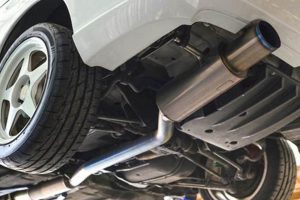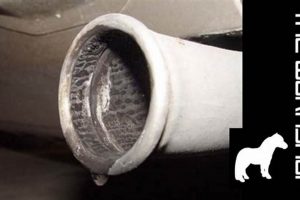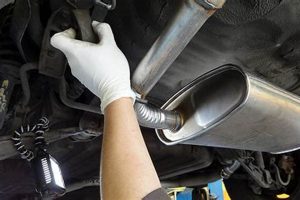The automotive exhaust system component significantly reduces the acoustic intensity of engine noise. Functioning as an acoustic filter, it contains a series of chambers and tubes designed to reflect and absorb sound waves produced by the engine’s combustion process. This component is typically positioned along the exhaust system, downstream from the catalytic converter.
Effective noise reduction enhances the driving experience for both the operator and occupants, contributing to a more comfortable cabin environment. Furthermore, controlling vehicle noise pollution offers considerable benefits to the broader environment and public health by mitigating excessive sound levels within urban areas. Historically, its development parallels advancements in engine technology and increasing societal concerns regarding noise pollution.
The subsequent sections will delve into the construction materials, operational principles, maintenance considerations, and performance impacts related to this vital element of vehicle operation.
Preserving Exhaust System Integrity
The longevity and optimal performance of this vehicle component depend on adherence to specific maintenance and operational practices.
Tip 1: Regular Visual Inspections: Conduct routine examinations for signs of corrosion, physical damage (dents, punctures), or leaks. Early detection prevents minor issues from escalating into major failures.
Tip 2: Address Unusual Noises Promptly: Investigate any atypical sounds emanating from the exhaust system immediately. Rattling, hissing, or roaring noises often indicate a developing problem, such as a loose connection or internal component failure.
Tip 3: Avoid Short Trip Driving Predominantly: Minimize frequent short journeys, as they prevent the exhaust system from reaching its optimal operating temperature. This encourages the accumulation of condensation and corrosive acids, accelerating deterioration.
Tip 4: Ensure Proper Exhaust System Mounting: Verify that all mounting brackets and hangers are secure and free from damage. Loose or broken supports can cause excessive vibration and stress, leading to premature failure.
Tip 5: Promptly Repair Exhaust Leaks: Address any identified leaks without delay. Exhaust gases contain harmful substances, and leaks can compromise passenger safety and environmental integrity, also negatively affecting engine performance.
Tip 6: Consider Material Upgrades for Longevity: When replacement becomes necessary, explore options constructed from more corrosion-resistant materials, such as stainless steel, particularly in regions with harsh winter climates or exposure to road salts.
Implementing these measures effectively mitigates the risk of premature failure, extending the operational lifespan and preserving the performance of the vehicle’s exhaust system.
The subsequent section will present a comprehensive overview of the performance and environmental implications of a properly functioning system.
1. Noise Reduction
The effective attenuation of engine exhaust noise is a primary function of the automotive exhaust system component under discussion. Its design and condition directly influence the sound levels emitted by a vehicle. This relationship necessitates a clear understanding of the principles governing noise reduction within this specific context.
- Acoustic Absorption and Reflection
The internal structure of the component, often incorporating baffles, resonators, and sound-absorbing materials, is engineered to manipulate sound waves. Baffles redirect sound energy, causing destructive interference, while resonators cancel specific frequencies. Materials like fiberglass further absorb sound energy, converting it to heat. This multifaceted approach minimizes the sound pressure reaching the environment.
- Frequency Attenuation
Different engine operating conditions generate a range of sound frequencies. The component is designed to selectively attenuate these frequencies, targeting those most objectionable to the human ear. For example, low-frequency rumble is often addressed through strategically sized chambers, while high-frequency hissing is mitigated using absorbent materials. Effective frequency-specific attenuation contributes significantly to overall noise reduction.
- Backpressure Considerations
While the primary objective is noise reduction, it is crucial to minimize backpressure introduced into the exhaust system. Excessive backpressure can negatively impact engine performance, reducing power output and fuel efficiency. The design balances noise reduction with exhaust flow optimization, requiring careful consideration of internal geometry and material selection.
- Material Degradation and Noise Increase
Over time, exposure to heat, moisture, and corrosive exhaust gases can degrade the internal components, reducing their ability to effectively attenuate sound. Corrosion of baffles, loss of absorbent material, and the development of leaks all contribute to increased noise levels. Regular inspection and maintenance are essential to preserve optimal noise reduction performance.
The correlation between the functional state of this component and the resulting noise level underscores its importance in maintaining vehicle compliance with noise regulations and enhancing the overall driving experience. Degradation of these noise reduction mechanisms leads directly to increased noise pollution and potential regulatory non-compliance.
2. Exhaust System
The exhaust system serves as an integrated network for channeling combustion byproducts away from the engine, treating harmful emissions, and mitigating noise. The automotive exhaust system component plays a crucial role within this network, specifically targeting the reduction of acoustic output generated by the engine’s operation. Its function is inextricably linked to the overall performance and environmental impact of the entire exhaust system.
- Components and Configuration
The exhaust system typically comprises the exhaust manifold, catalytic converter, resonator (optional), the component under discussion, and tailpipe. The component is typically located downstream from the catalytic converter, maximizing its effectiveness in suppressing noise generated after the catalytic conversion process. The specific configuration can vary based on vehicle type and emission control requirements.
- Backpressure Implications
The design of each component within the exhaust system contributes to the overall backpressure experienced by the engine. While it effectively reduces noise, an improperly designed or obstructed component can significantly increase backpressure, leading to reduced engine efficiency, diminished power output, and increased fuel consumption. Optimizing exhaust flow while maintaining noise reduction remains a key design consideration.
- Material Selection and Durability
The exhaust system, including the component, is subjected to extreme temperature fluctuations and corrosive substances. Material selection directly impacts system longevity and performance. Common materials include aluminized steel and stainless steel, with stainless steel offering superior corrosion resistance and extended lifespan. The integrity of the component material directly affects its ability to effectively attenuate noise over time.
- Emissions Control Integration
While not directly involved in emissions treatment, a properly functioning component supports the effectiveness of upstream emissions control devices, such as the catalytic converter. Excessive backpressure caused by a malfunctioning component can negatively impact the converter’s efficiency, leading to increased emissions output. Therefore, maintaining the integrity of the entire exhaust system, including the component, is crucial for meeting emission standards.
Understanding the intricate relationship between the component, the exhaust system, and engine performance is essential for optimizing vehicle efficiency and minimizing environmental impact. Focusing solely on noise reduction without considering the broader system dynamics can lead to unintended consequences, highlighting the need for a holistic approach to exhaust system design and maintenance.
3. Material Durability
Material durability is a critical factor governing the lifespan and performance of an automotive exhaust system component. The materials used in its construction must withstand exposure to high temperatures, corrosive exhaust gases, road salts, and physical impacts from road debris. Inadequate material durability leads to premature failure, increased noise pollution, and potential engine performance degradation. For example, the use of low-grade steel results in rapid corrosion, compromising the component’s structural integrity and acoustic dampening capabilities.
Stainless steel, while more expensive, exhibits superior resistance to corrosion compared to aluminized steel or low-carbon steel. This enhanced durability translates to a longer service life, reduced maintenance requirements, and sustained performance in harsh operating conditions. Consider the impact of winter road salting practices on exhaust systems; components constructed from less durable materials experience accelerated corrosion in regions where such practices are common. The selection of appropriate materials during manufacturing is, therefore, paramount to ensure the component functions effectively throughout its intended lifespan.
In summary, the durability of materials directly influences the operational effectiveness and longevity of the component. The choice of materials represents a trade-off between cost and performance; however, selecting more durable materials often proves to be a cost-effective strategy in the long term by minimizing replacement frequency and ensuring consistent performance. Addressing material durability is thus a fundamental aspect of component design and maintenance.
4. Engine Performance
The performance characteristics of an internal combustion engine are intrinsically linked to the exhaust system, wherein an automotive exhaust system component constitutes a crucial element. Specifically, the design and condition of this component impact engine backpressure. Excessive backpressure restricts the free flow of exhaust gases, leading to reduced volumetric efficiency, diminished power output, and increased fuel consumption. A clogged or poorly designed component effectively chokes the engine, hindering its ability to efficiently expel exhaust products. As an example, replacing a corroded, restrictive component with a high-flow alternative can demonstrably improve horsepower and torque, particularly at higher engine speeds.
Conversely, an excessively free-flowing exhaust system, resulting from the removal or modification of the component, can also negatively affect engine performance. Without adequate backpressure, scavenging efficiency may be reduced, leading to incomplete combustion and a loss of low-end torque. This phenomenon is particularly noticeable in smaller displacement engines, where maintaining optimal exhaust velocity is critical for efficient cylinder filling. The precise balance between exhaust flow and backpressure must, therefore, be carefully calibrated to the specific engine characteristics.
In conclusion, the relationship between the automotive exhaust system component and engine performance is complex and multifaceted. Optimal engine performance necessitates a carefully designed component that minimizes backpressure while effectively attenuating noise. Maintaining the component in good working order, ensuring proper sizing and design, is essential for preserving engine efficiency, power output, and fuel economy. Modifying or neglecting this component can yield unintended consequences, underscoring the importance of a comprehensive understanding of its role within the overall engine system.
5. Environmental Impact
The environmental impact of a vehicle’s exhaust system, including the automotive exhaust system component, extends beyond simple noise pollution. The component’s efficiency and integrity directly influence emissions levels and resource consumption throughout its lifecycle.
- Noise Pollution Mitigation
The primary environmental benefit is the reduction of noise pollution. Excessive vehicular noise contributes to stress, sleep disturbance, and hearing impairment in human populations, as well as disruption of wildlife habitats. A properly functioning component effectively minimizes the acoustic footprint of vehicles, contributing to improved quality of life and ecosystem health. A failing component results in increased noise levels, negating this benefit and exacerbating noise pollution issues.
- Fuel Efficiency and Emissions
A damaged or improperly designed component can increase backpressure within the exhaust system. This increased backpressure reduces engine efficiency, leading to increased fuel consumption and higher emissions of greenhouse gases (e.g., carbon dioxide) and criteria air pollutants (e.g., nitrogen oxides, particulate matter). A well-maintained, appropriately sized component contributes to optimal engine performance, minimizing fuel consumption and reducing overall emissions output.
- Material Composition and Recycling
The materials used in the construction of the component have environmental implications. Production of steel, particularly stainless steel, requires significant energy input and can generate substantial pollution. The end-of-life management of the component is also crucial. Recycling steel conserves resources and reduces energy consumption compared to producing virgin materials. However, improper disposal can lead to land contamination and resource depletion. Designing components for recyclability and promoting responsible end-of-life management minimize their environmental footprint.
- Catalytic Converter Performance
While not directly involved in emissions control, its functionality supports the performance of the catalytic converter. Excessive backpressure caused by a malfunctioning component can negatively impact the converter’s efficiency, leading to increased emissions of harmful pollutants. Maintaining a functional component ensures optimal conditions for the catalytic converter to effectively reduce emissions of carbon monoxide, hydrocarbons, and nitrogen oxides, thus minimizing the vehicle’s contribution to air pollution.
The environmental impact related to it is multifaceted, encompassing noise pollution, fuel consumption, emissions control, and resource utilization. Addressing these factors through responsible design, maintenance, and end-of-life management is essential for minimizing the environmental footprint of vehicles and promoting sustainable transportation practices.
6. Vehicle Compliance
Compliance with noise emission regulations is a significant aspect of vehicle certification, and the automotive exhaust system component plays a crucial role in achieving these standards. Governmental agencies worldwide establish maximum permissible noise levels for vehicles, aiming to mitigate noise pollution in urban and residential areas. The component functions as a primary means of reducing engine exhaust noise to comply with these regulations. For example, vehicles exceeding established decibel limits due to a defective or modified component fail to meet regulatory requirements, potentially incurring fines or prohibiting operation on public roads. Its design and maintenance are, therefore, directly linked to adherence to legal standards.
The effectiveness of this component in noise reduction must be verifiable through standardized testing procedures. These tests simulate various driving conditions and measure the resulting noise levels. The component must consistently perform within acceptable parameters to ensure vehicle compliance. Furthermore, modifications to the exhaust system, such as removing or altering the component, can void vehicle compliance certifications, even if other vehicle systems meet required standards. The cause-and-effect relationship is clear: a functional component directly contributes to vehicle compliance, whereas a non-functional or modified component compromises it.
In summary, the relationship between vehicle compliance and the automotive exhaust system component is critical for legal operation. The component is a fundamental element in meeting noise emission regulations, with its design and maintenance directly affecting a vehicle’s ability to adhere to established standards. Failure to maintain this component or unauthorized modifications can lead to non-compliance, resulting in legal penalties and restricting vehicle use. Therefore, understanding the regulatory context and ensuring its proper function are essential aspects of responsible vehicle ownership and operation.
Frequently Asked Questions
This section addresses common inquiries regarding the function, maintenance, and performance of the component, providing concise and informative answers.
Question 1: What is the primary function of the automotive exhaust system component?
The primary function is to reduce the acoustic intensity of engine exhaust noise, contributing to a quieter driving experience and mitigating noise pollution.
Question 2: How does a malfunctioning component affect engine performance?
A malfunctioning component can increase backpressure, leading to reduced engine efficiency, diminished power output, and increased fuel consumption. Conversely, the removal or excessive modification can also negatively affect engine performance.
Question 3: What materials are commonly used in construction, and what are their relative advantages?
Common materials include aluminized steel and stainless steel. Stainless steel offers superior corrosion resistance and extended lifespan compared to aluminized steel.
Question 4: How often should the automotive exhaust system component be inspected?
The component should be inspected during routine vehicle maintenance, with particular attention paid to signs of corrosion, physical damage, or unusual noises.
Question 5: Does replacing the component with a performance aftermarket part void the vehicle’s warranty?
Replacing with non-OEM performance parts may, depending on specific warranty terms and applicable laws. Consult the vehicle’s warranty documentation and relevant legal provisions.
Question 6: What are the environmental implications of a damaged or removed component?
A damaged component can increase noise pollution, reduce fuel efficiency, and negatively impact the performance of the catalytic converter, leading to increased emissions. Removal of the component typically results in non-compliance with noise emission regulations.
In summary, proper maintenance and understanding of this automotive exhaust system component are essential for optimal vehicle performance, noise reduction, and environmental responsibility.
The next section will explore advanced diagnostic techniques for identifying potential issues within the exhaust system.
Conclusion
The preceding exploration has delineated the multifaceted significance of a “muffler on a car,” extending beyond mere noise reduction. It has revealed its critical interplay with engine performance, environmental impact, and regulatory compliance. Its design and structural integrity directly influence fuel efficiency, emissions output, and adherence to legally mandated noise levels. Neglecting its maintenance or implementing ill-advised modifications can precipitate a cascade of detrimental effects, ultimately compromising the vehicle’s overall functionality and environmental responsibility.
Therefore, a thorough understanding of this often-overlooked component is paramount for responsible vehicle ownership and operation. A proactive approach to maintenance, informed material selection during replacements, and adherence to regulatory guidelines are crucial for maximizing its lifespan, optimizing its performance, and ensuring its continued contribution to a cleaner and quieter environment. Consider the long-term implications of component neglect and prioritize its proper care as an integral aspect of comprehensive vehicle management.







